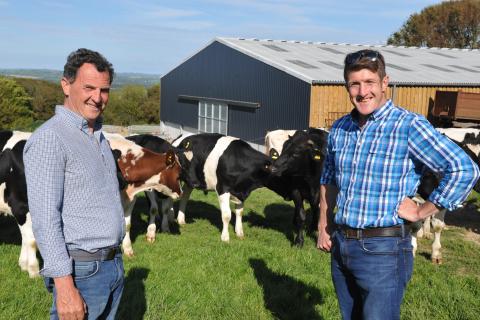4 June 2019
Welsh suckler beef producers could halve their winter housing period and associated costs by establishing a rotational system of grazing.
James Evans has proven this is possible since putting the grazing system in place for the herd of 300 Stabiliser cattle he runs on a contract farming agreement.
He has shortened the housing period from six months to just three and reduced silage usage by 50%.
During a Farming Connect Knowledge Transfer Event in Ceredigion, Mr Evans admitted that a decision to switch to organic production by the farm owners changed his attitude to grazed grass.
“Rather than accepting reduced profits and production by keeping things as they were, we decided to focus more on grass,’’ said Mr Evans, who farms at Partridge Farm, Bishop’s Castle.
He employed a grazing consultant as “a fresh pair of eyes’’. “He made me realise that we weren’t utilising grass in the way we should be,’’ Mr Evans told farmers attending the event at Penrallt Farm, Llantood, kindly hosted by Geraint Evans.
A series of 1 hectare (ha) paddocks was created by establishing a semi-permanent electric fence around the perimeter of the area earmarked for grazing and further dividing these with electric fencing.
Each paddock is grazed for two or three days by 40-50 cows and their calves.
“Rotational grazing has allowed us to extend our grazing period. Some cattle aren’t housed at all, they are either wintered on deferred grazing or on forage crops such as rape and kale undersown with Italian ryegrass,’’ said Mr Evans.
Water is supplied to each paddock via a portable trough connected to above ground water pipes.
This system has helped overcome the challenge of supplying drinking water to each paddock. “We have all seen rotational grazing working in dairy systems but suckler farmers think it might not work for them because they mostly have smaller mobs for grazing and believe there will be an issue with water supply.
“We have put pipework on top of the land and that allows us to have a portable water trough which we can move around every paddock.’’
All the breeding bulls are grass-fed when they are sold at 18 months and this creates additional interest among buyers, Mr Evans said. “There is a demand for bulls that have been raised on grass and perform well on it. Farmers want genetics that have been proven off grass.’’
Mr Evans will be speaking at further Farming Connect events at Raglan and Ruthin in June. For further information visit the Farming Connect Events page.
Sarah Hughes, Farming Connect Red Meat Technical Officer (South West Wales), who organised the event at Penrallt Farm, said Mr Evans had demonstrated that by focusing on grassland management it is possible for farmers to reduce their costs.
“In a recent benchmarking survey, the top 25% of farmers were monitoring their overheads, focusing on details and understanding their markets. Better utilisation of grazed grass is part of that,’’ she said.
The Farming Connect event was also an opportunity for farmers to learn more about BeefQ, a project supported by the Welsh Government Rural Communities - Rural Development Programme 2014-2020 which aims to validate an eating quality assessment system in Wales.
The project is coordinated by the Institute of Biological, Environmental and Rural Sciences (IBERS), Aberystwyth University, and is a collaboration between key academic and industry organisations including HCC, Menter a Busnes, Celtica Foods Ltd, Queens University Belfast, Birkenwood Pty Ltd from Australia and several meat processors in Wales.
Dr Eleri Price, of Hybu Cig Cymru – Meat Promotion Wales, said the BeefQ project offered exciting opportunities for Welsh beef producers.
“The carcass assessment, along with information on animal production system and carcass processing, will be inputted to a model which will predict the eating quality of carcass cuts,’’ she said.
“This will be verified using consumer taste-testing. Producers of PGI Welsh Beef will be able to see data on the ‘eating quality’ of the beef they produce, helping to provide beef of higher and more consistent quality to the consumer.’’
Click here for further information.
The Welsh Government Rural Communities - Rural Development Programme 2014-2020 is funded by the European Agricultural Fund for Rural Development and the Welsh Government.
James Evans’ tips for converting to a rotational grazing system
- Get expert help. “Getting another pair of eyes on the farm is invaluable, often we can’t see what needs to be done because we are too close to our own businesses.’’
- Get used to spending money in different ways. Mr Evans invested £15,000 to establish a rotational grazing system but this was a one-off payment. “It seemed a lot of money at the time even though we wouldn’t have thought twice about spending £15,000 on buying a few loads of feed or replacing a machine under the old system.’’
- Graze a paddock for up to three days then rest it. “When you turn a lot of cattle into a paddock they just want to want to eat the most palatable bits but this takes the energy source away from the roots and you are left with tussocks that have to be topped. Make them eat everything and in time you will improve permanent pasture that would have previously been deemed to be unpalatable.’’
- Good infrastructure will ease management

